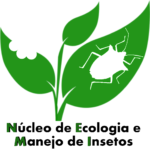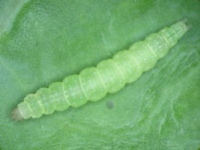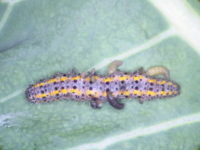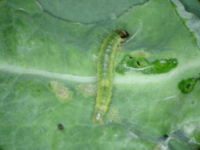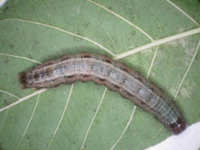-
Welcome to the website of the Laboratory of Insect Ecology and Management (NEMI)! In this space, we will publicize our research and extension activities related to the themes:
-
________________________ News from NEMI ________________________
-
Prevention is better than cure
 There is nothing new about the conception of prevention being better than cure. In fact, this concept is true for several situations, including regarding the invasion of insect pests. Studies show that 70 billion dollars are annually spent worldwide to control and manage invasive insect species. It is now quite clear that preventing new introductions is more cost-effective than managing insect pests after the invasion has occurred, as demonstrated by several studies.
There is nothing new about the conception of prevention being better than cure. In fact, this concept is true for several situations, including regarding the invasion of insect pests. Studies show that 70 billion dollars are annually spent worldwide to control and manage invasive insect species. It is now quite clear that preventing new introductions is more cost-effective than managing insect pests after the invasion has occurred, as demonstrated by several studies.Government enforcement agencies are responsible for adopting preventive measures against introduction of insect pests, but how do you know where they are most likely to occur? With that question in mind, our group developed a methodology that combines data on habitat suitability, the presence of invasion pathways (airports and ports), and invasion and establishment likelihood maps for the 21st century to identify areas at higher risk of invasion by insect pests. Such maps can be used in the prioritization of areas for the adoption of phytosanitary measures against invasive species. This information is important because, in addition to the costs associated with managing agricultural pests, there is a serious risk of environmental contamination due to the increased use of pesticides for controlling the new invader.
The paper entitled “Prevention is better than cure: Integrating habitat suitability and invasion threat to assess global biological invasion risk by insect pests under climate change” was published in the journal Pest Management Science, and can be accessed in full here. This study was carried out in social isolation due to the pandemic, and this was only possible due to the efforts of several professionals working on essential services.
-
For the southern armyworm, the hotter the better?
 This was the question we asked in the title of the new paper published by NEMI. The questioning refers to the southern armyworm (Spodoptera eridania), an agricultural pest that has been causing significant damage to soybean and other economically important crops. Because insects do not regulate their body temperature, variations in air temperature drastically affect their development and survival. In general, the higher the temperature, the faster the development and population growth of insects. However, one can question whether the predicted increase in temperature due to climate change will exceed the upper threshold tolerated by the southern armyworm. To answer this question we used information on the southern armyworm biology obtained under laboratory conditions at UFSC campus of Curitibanos, mathematical models, and daily temperature data for southern Brazil.
This was the question we asked in the title of the new paper published by NEMI. The questioning refers to the southern armyworm (Spodoptera eridania), an agricultural pest that has been causing significant damage to soybean and other economically important crops. Because insects do not regulate their body temperature, variations in air temperature drastically affect their development and survival. In general, the higher the temperature, the faster the development and population growth of insects. However, one can question whether the predicted increase in temperature due to climate change will exceed the upper threshold tolerated by the southern armyworm. To answer this question we used information on the southern armyworm biology obtained under laboratory conditions at UFSC campus of Curitibanos, mathematical models, and daily temperature data for southern Brazil.Our results showed that the increase in temperature predicted by different climate change scenarios will favor the population growth of the southern armyworm in most of southern Brazil, especially in northern Rio Grande do Sul and in the mountainous regions of Santa Catarina. On the other hand, the higher temperatures predicted for northwestern Paraná will negatively affect this species. These results have implications for the management of the southern armyworm, whose recent outbreaks in Bt soybean crops have worried farmers.
Our paper entitled “The hotter the better? Climate change and voltinism of Spodoptera eridania estimated with different methods” was published in the Journal of Thermal Biology, and can be obtained here.
Soon we will bring news about other publications of NEMI!
-
Climate warming may affect tomato pest
 Like other living organisms, insects have adapted to the climatic conditions to which they were exposed throughout their evolutionary process. Rapid changes in climatic conditions can generate significant changes in the population growth of insects, with potential ecological, health, and economic consequences. In the case of agricultural pests, greater population growth can lead to more severe damage to crops.
Like other living organisms, insects have adapted to the climatic conditions to which they were exposed throughout their evolutionary process. Rapid changes in climatic conditions can generate significant changes in the population growth of insects, with potential ecological, health, and economic consequences. In the case of agricultural pests, greater population growth can lead to more severe damage to crops. Our group published a paper in the journal Bulletin of Entomological Research that investigated how the small tomato borer, Neoleucinodes elegantalis responds to variations in temperature and applied that knowledge to predict how global warming might influence the annual number of generations of this pest in southern Brazil. Our models predicted that most of southern Brazil will experience an increase in the number of generations of the small tomato borer, especially the colder regions comprising the highest altitude areas in the mountainous mesoregion of Santa Catarina and in northern Rio Grande do Sul. In such regions, the increase in the number of generations can be up to 37%. Our findings have important implications for the knowledge of the possible vulnerabilities of the agricultural sector due to climate change.
Our group published a paper in the journal Bulletin of Entomological Research that investigated how the small tomato borer, Neoleucinodes elegantalis responds to variations in temperature and applied that knowledge to predict how global warming might influence the annual number of generations of this pest in southern Brazil. Our models predicted that most of southern Brazil will experience an increase in the number of generations of the small tomato borer, especially the colder regions comprising the highest altitude areas in the mountainous mesoregion of Santa Catarina and in northern Rio Grande do Sul. In such regions, the increase in the number of generations can be up to 37%. Our findings have important implications for the knowledge of the possible vulnerabilities of the agricultural sector due to climate change.The paper entitled “Selection of models to describe the temperature-dependent development of Neoleucinodes elegantalis (Lepidoptera: Crambidae) and its application to predicting the species voltinism under future climate conditions” was carried out by the agronomy student Hevellyn Talissa dos Santos as part of its scientific initiation studies. The full paper can be accessed in this link.
Soon more updates on the studies carried out by our group!
-
A brand new paper published by NEMI
 As we know, air temperature varies over years and regions. While some summers can be warmer, others are milder, and the same can happen for the other seasons. This variation is related to natural phenomena that act at a regional and global level, such as El Niño, La Niña, and the North Atlantic Oscillation, among others. Also, it is widely known that temperatures tend to be higher at lower latitudes closer to the Equator and lower at higher latitudes and altitudes. For example, the average annual temperature is higher in northern Brazil (lower latitude) compared to the south (higher latitude). Similarly, annual average temperatures are higher on the Santa Catarina coast (lower altitude) compared to the mountainous region of the state (higher altitude), despite being at the same latitude.
As we know, air temperature varies over years and regions. While some summers can be warmer, others are milder, and the same can happen for the other seasons. This variation is related to natural phenomena that act at a regional and global level, such as El Niño, La Niña, and the North Atlantic Oscillation, among others. Also, it is widely known that temperatures tend to be higher at lower latitudes closer to the Equator and lower at higher latitudes and altitudes. For example, the average annual temperature is higher in northern Brazil (lower latitude) compared to the south (higher latitude). Similarly, annual average temperatures are higher on the Santa Catarina coast (lower altitude) compared to the mountainous region of the state (higher altitude), despite being at the same latitude. Given that temperature is considered one of the main factors influencing the biology and population dynamics of insects, our group carried out a study recently published in the journal Neotropical Entomology on the spatial and temporal variation in the number of annual generations of insect pests in Southern Brazil. Southern Brazil is the perfect study area for this type of analysis due to its marked climatic heterogeneity.
Our findings showed that location was the main factor influencing the annual number of generations of the studied species. The interannual variation in the number of generations was also influenced by location, being more pronounced in the coldest regions of the study area comprising the mountainous region of Santa Catarina and Rio Grande do Sul states. Our study provides an important contribution to the understanding of spatio-temporal variations in the voltinism of insects, and how temperature changes may increase their population growth. These findings indicate that some regions may be more susceptible to insect pest outbreaks than others.
More information on this subject can be obtained by accessing the full paper here. Soon we will bring more information about the studies developed by our group!
-
Environmental changes threaten stingless bees
Everyone knows that bees are important pollinators of wild and cultivated plants worldwide. However, few know that pollination is responsible for an increase of more than US$ 570 billion in annual agricultural production! Unfortunately, many species of bees are threatened by human-induced environmental changes. This phenomenon is often called as colony collapse disorder and refers to the disappearance of bee populations in certain regions of the world.
Recognizing which factors influence the disappearance of bees is essential to develop conservation measures in order to save these species and the ecosystem services they provide. Recently, our group assessed the changes in land use within the distribution range of 10 stingless bee species native to Brazil. As we know, converting natural forests to urban or agricultural use can negatively affect several species. We also evaluated the effects of climate change on the distribution of these species and the efficiency of environmental protection areas for their conservation.

Changes in the distribution range of 10 species of stingless bees. Click on the image to see it larger.
We found that in the last few decades, there has been an increase in the agricultural area and a reduction in the natural forests within the distribution range of the studied species. This result indicates that the more susceptible species to environmental change may have a reduction in the number of colonies. In addition, our models predicted that seven out of the ten species studied will face a reduction in the climatically suitable areas by 2070. To make matters worse, the existing protected areas network is not sufficient to conserve climatically suitable areas for the stingless bees. These results show that conservation measures should be taken in order to preserve these species. The full article was published in the journal Regional Environmental Changes and can be accessed by clicking here.
-
Temperature and agricultural pests
Animals such as mammals and birds are able to regulate their body temperature. In humans, the body temperature of a healthy person will be close to 36.5 ºC, regardless of the season. If our body temperature varies much below this value, there is a risk of hypothermia, if it reaches a value above 37.8 ºC, we have a fever. Both conditions can lead to death.
However, not all animals have the ability to regulate their body temperature as mammals and birds. Insects, for example, have a body temperature close to room temperature. For this reason, temperature is very important for the life cycle of these important animals. The higher the temperature, the faster the insect’s metabolism and, consequently, the faster it develops. The faster an insect develops, the faster its population increases. If the insect is an agricultural pest, the greater its population in the field, the greater the damage caused and the yield losses.
Given this close relationship between insect development and temperature, our research group studied how the southern armyworm (Spodoptera eridania), an important pest of several agricultural crops cultivated in Brazil, responds to different temperatures. We observed that at 15ºC the development time for this species was 120 days. When the same species are kept at 32ºC, the development time decreases to just 25 days! In addition, in this study, we used mathematical models to understand the relationship between temperature and the development of the southern armyworm. Together with daily temperature data, these models can be used to predict the occurrence of the southern armyworm in the field, helping the farmers to manage this important pest.
The paper entitled “Temperature-dependent development models describing the effects of temperature on the development of Spodoptera eridania” is part of the master thesis of Fábio Sampaio, and was published in the journal Pest Management Science. We will soon publish a paper on how climate change will affect the southern armyworm in southern Brazil.
Wait for new information!
-
New paper on the conservation of bumblebees
Did you know that more than 90% of the main global cash crops depend on pollinators for reproduction, and that pollination increases annual world crop production by up to US$ 577 billion? Furthermore, bees also pollinate several wild plants contributing to the conservation of forests. With this information in mind, it is easy to understand why efforts to conserve these important pollinators are necessary.
Unfortunately, declines in the bee population were globally recorded in the last few decades, mainly because of anthropogenic changes in the envvironment. Our research group has been working with brazilian native bees aiming to provide a framework for conservation strategies of these pollinators.
 Recently, we published a paper that employed mathematical models to assess the distribution of South American bumblebees of the genus Bombus under current, past and future climate conditions. Together with data on land use and the protected areas network, we were able to propose priority species and areas for conservation of bumblebees. Our findings show that three out of the six species evaluated are the most endangered and must have priority for conservation (Bombus bellicosus, B. brevivillus and B. brasiliensis). Additionally, we identified spatial priorities aiming at increasing the chances of bumblebees to survive in a given area in the long term.
Recently, we published a paper that employed mathematical models to assess the distribution of South American bumblebees of the genus Bombus under current, past and future climate conditions. Together with data on land use and the protected areas network, we were able to propose priority species and areas for conservation of bumblebees. Our findings show that three out of the six species evaluated are the most endangered and must have priority for conservation (Bombus bellicosus, B. brevivillus and B. brasiliensis). Additionally, we identified spatial priorities aiming at increasing the chances of bumblebees to survive in a given area in the long term. Our lab is still studying native bees given they essenial role on food production and ecosystem functioning. Soon more information about our studies will be available!
The above information was originally published in the paper: Krechemer, FS & Marchioro, CA. 2020. Past, present, and future distributions of bumble bees in South America: identifying priority species and areas for conservation. Journal of Applied Ecology.
-
Pollinators and plants can be affected by climate change
 Living organisms are adapted to the environmental conditions they live in, including the climate to which they have been exposed throughout their evolution. Rapid changes in climate that hamper the species’ adaptation can result in drastic changes in their distribution range. Understanding the important impact that these changes can have on ecosystems and human well-being, several studies have been dedicated to predicting how species will respond to climate change. However, comparatively few studies have evaluated how these changes can impact the interaction between species.
Living organisms are adapted to the environmental conditions they live in, including the climate to which they have been exposed throughout their evolution. Rapid changes in climate that hamper the species’ adaptation can result in drastic changes in their distribution range. Understanding the important impact that these changes can have on ecosystems and human well-being, several studies have been dedicated to predicting how species will respond to climate change. However, comparatively few studies have evaluated how these changes can impact the interaction between species.Our group developed a study recently published in the journal Apidologie to evaluate this issue. The study used the stingless bees popularly known as mandaçaias (indigenous word meaning beautiful) and bracatinga as a model system. Because the response to climate change is species-specific, our models predicted a drastic reduction of up to 94% in the spatial interaction between pollinators and bracatinga by the end of this century. Considering the important role that pollinators play on food production and forest maintenance, our results indicate that changes such as those predicted by our models can have severe consequences for human well-being if greenhouse gas emission is not reduced.
The paper entitled “Climate change can affect the spatial association between stingless bees and Mimosa scabrella in the Brazilian Atlantic Forest” can be accessed here.
Soon we will have news about another study developed by our group on the conservation of native Brazilian bees!

